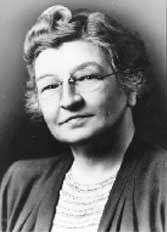Professional career
Unable to find work as an engineer, Clarke went to work for General Electric as a supervisor of computers in the Turbine Engineering Department. During this time, she invented the Clarke calculator, an early graphing calculator, a simple graphical device that solved equations involving electric current, voltage and impedance in power transmission lines. The device could solve line equations involving hyperbolic functions ten times faster than previous methods. She filed a patent for the calculator in 1921 and it was granted in 1925.
In 1921, Clarke took a leave of absence from GE to teach physics at the Constantinople Women's College in Turkey because she was not allowed to do electrical engineering work, was not earning the same salary and had a lower professional status as men doing the same work. The next year, when she returned from Turkey, she was offered a job by GE as a salaried electrical engineer in the Central Station Engineering Department – the first professional female electrical engineer in the United States. She retired from General Electric in 1945.
Her background in mathematics helped her achieve fame in her field. On February 8, 1926, as the first woman to deliver a paper at the American Institute of Electrical Engineers' (AIEE) annual meeting, she showed the use of hyperbolic functions for calculating the maximum power that a line could carry without instability. The paper was of importance because transmission lines were getting longer, leading to greater loads and more chances for system instability, and Clarke's paper provided a model that applied to large systems. Two of her later papers won awards from the AIEE: the Best Regional Paper Prize in 1932 and the Best National Paper Prize in 1941.
She also worked on the design and building of hydroelectric dams in the West including Hoover Dam, contributing her electrical expertise to develop and install the turbines that generate hydropower there to this day.
In 1943, Clarke wrote an influential textbook in the field of power engineering, Circuit Analysis of A-C Power Systems, based on her notes for lectures to GE engineers. This two-volume textbook teaches about her adaption of the symmetrical components system, in which she became interested while working for the second time at GE. This system is a mathematical means for engineers to study and solve problems of power system losses and the performance of electrical equipment. Clarke adopted this system to the three-phase components that are the basis of the electrical grid in the United States. This textbook was used as the basis of education for electrical engineers for many years.
In 1947, she joined the faculty of the Electrical Engineering Department at the University of Texas at Austin, making her the first female professor of electrical engineering in the country. She taught for 10 years and retired in 1957.
In an interview with The Daily Texan on March 14, 1948, Clarke observed: "There is no demand for women engineers, as such, as there are for women doctors; but there's always a demand for anyone who can do a good piece of work."
